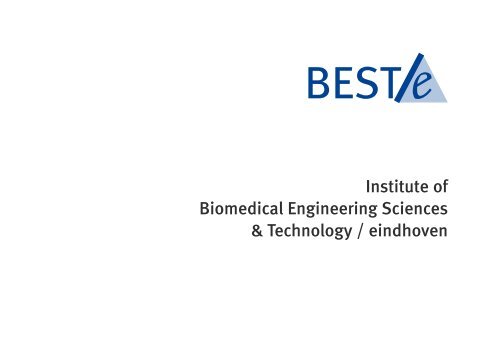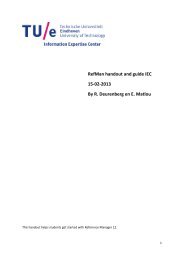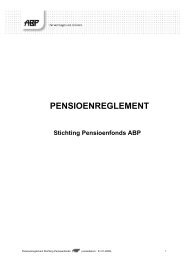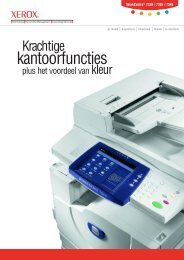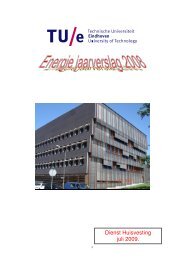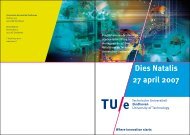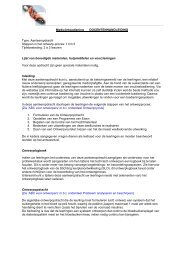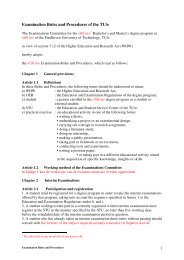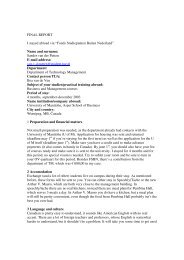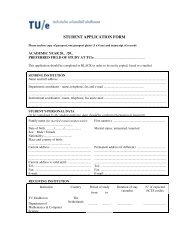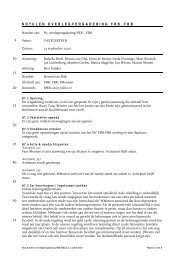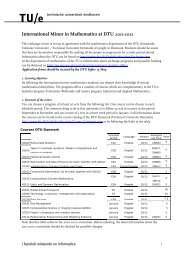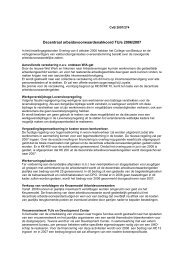BEST e - Technische Universiteit Eindhoven
BEST e - Technische Universiteit Eindhoven
BEST e - Technische Universiteit Eindhoven
Create successful ePaper yourself
Turn your PDF publications into a flip-book with our unique Google optimized e-Paper software.
<strong>BEST</strong> e<br />
Institute of<br />
Biomedical Engineering Sciences<br />
& Technology / eindhoven<br />
12
Table of Contents<br />
2<br />
1. Introduction 4<br />
2. Education 6<br />
Graduate School <strong>BEST</strong>/e 6<br />
School for Medical Physics and Engineering SMPE/e 6<br />
3. Research 8<br />
Mission Statement 8<br />
Molecular Bioengineering and Molecular Imaging (MBEMI) 8<br />
Biomechanics and Tissue Engineering (BMTE) 10<br />
Biomedical Imaging and Modeling (BIOMIM) 10<br />
4. Collaboration with Maastricht 14<br />
5. Department of Biomedical Engineering 16<br />
5.1 Biomedical Chemistry 16<br />
5.1.1 Dendritic architectures 16<br />
5.1.2 Supramolecular Biomaterials 18<br />
5.1.3 Protein Engineering 19<br />
5.1.4 Clinical Chemistry 19<br />
5.2 Biomedical NMR 20<br />
5.2.1 The cardiovascular system 21<br />
5.2.2 Molecular imaging 21<br />
5.2.3 Skeletal muscle 22<br />
5.3 Soft Tissue Biomechanics and Tissue Engineering 24<br />
5.3.1 Tissue Engineering 24<br />
5.3.2 Soft Tissue Mechanics 26<br />
5.3.3 Multi-Phase Mechanics 27<br />
5.4 Cardiovascular Biomechanics 28<br />
5.4.1 Hemodynamics and Vascular Biomechanics 28<br />
5.4.2 Cardiac Biomechanics 30<br />
5.5 Bone and Orthopaedic Biomechanics 31<br />
5.5.1 Mechanical Properties of Bone & Osteoporosis 31<br />
5.5.2 Mechanobiology of Tissue Differentiation 32<br />
5.5.3 Osteoarthrosis & Artificial joints 34<br />
5.5.4 The healing touch of a plasma needle 35<br />
5.6 Biomedical Image Analysis 36<br />
5.6.1 Multi-scale image structure 36<br />
5.6.2 Visualization and Clinical Applications 38<br />
5.6.3 Molecular Imaging of the Ischemic Heart 39<br />
5.7 Biomodeling and Bioinformatics 40<br />
5.7.1 Protein, Membrane, and Cell Simulations 40<br />
5.7.2 Tissue simulations<br />
5.7.3 Metabolic pathways, genetic algorithms,<br />
41<br />
bioinformatics 42<br />
6. Department of Electrical Engineering 44<br />
6.1 BioSignals and Regulation<br />
6.1.1 Generic methods from system and control<br />
44<br />
theory for biosystems<br />
6.1.2 Applications in computational Systems Biology<br />
44<br />
and physiology 46<br />
6.2 Medical Signal Processing 47<br />
6.2.1 Fetal monitoring. 47<br />
6.2.2 Neuromonitoring 48<br />
6.2.3 Medical image and video processing chains 50<br />
6.2.4 Peri-operative signal processing 51<br />
7. Department of Applied Physics 52<br />
7.1 Molecular Biosensors for Medical Diagnostics<br />
7.1.1 Properties, actuation and detection of magnetic<br />
52<br />
nanoparticles 52<br />
<strong>BEST</strong> e<br />
7.1.2 Biophysics: protein detection, biochemical binding,<br />
and cell diagnostics 54<br />
8. Department of Mechanical Engineering 56<br />
8.1 Micro- and Nanoscale Engineering<br />
8.1.1 Bead based fluid actuation techniques for<br />
56<br />
immunoassay devices 56<br />
8.2 Mechanics of Materials 58<br />
8.2.1 Mechanics of biomedical devices 58<br />
8.2.2 Injury biomechanics 59<br />
8.3 Dynamics and Control Technology 60<br />
8.3.1 Medical Robotics 61<br />
9. Department of Mathematics and Computer Science 62<br />
9.1 Differential Equations in the Life Sciences<br />
9.1.1 Mixed finite elements for the modeling of<br />
62<br />
cartilaginous tissues<br />
9.1.2 Metabolic Control Analysis in spatially<br />
62<br />
heterogeneous systems 64<br />
9.1.3 Is bone remodeling an optimization algorithm? 65<br />
10. Research Input 66
Introduction<br />
4<br />
Technology has become indispensable in current medical research, diagnostics, treatment and care.<br />
Representative examples are found in protein engineering for biomolecular imaging and novel drug<br />
design, various imaging modalities, including vital imaging to study molecular events at the cellular<br />
and tissue level, functional MRI and ultra-sound, image analysis, treatment using artificial implants,<br />
the emerging field of regenerative medicine, including tissue engineering, and the use of<br />
computational tools to enhance diagnostics and surgical intervention.<br />
Research in biomedical engineering sciences aims to further the use of engineering principles<br />
and tools to unravel the pathophysiology of diseases and to enhance diagnostics, intervention and<br />
treatment of diseases. The choice made in <strong>Eindhoven</strong>, in collaboration with the University of<br />
Maastricht, is to focus our main research efforts on three interrelated themes:<br />
• Molecular bioengineering and molecular imaging,<br />
• Biomechanics and tissue engineering,<br />
• Biomedical imaging and modeling.<br />
Advances in molecular biology enable the detailed investigation of the pathophysiology of many<br />
diseases, as well as their treatment. Critical parameters in this research are the ability to synthesize<br />
new supramolecular systems and to manipulate proteins. These capabilities enable biomolecular<br />
imaging, using for instance confocal microscopy at the cellular and tissue level, and MRI to examine<br />
molecular events in the whole body. Treatment involves the design of new drugs and site specific drug<br />
delivery systems. Furthermore, our synthetic capabilities foster the design of new materials in which<br />
biological systems are mimicked or expanded in order to obtain materials with new functions or<br />
properties. Applications are found in the field of biosensors and regenerative medicine and tissue<br />
engineering.<br />
Introduction<br />
The rapidly emerging field of tissue engineering aims to reconstitute functional tissues and<br />
organs, either in-vitro or in-vivo. We have chosen to focus our research effort on load bearing tissues<br />
with emphasis on cardiovascular tissues. The prime challenge is to create living, autologous tissues<br />
that can sustain physiological loading, adapt to functional demand changes and grow. The key<br />
biomechanical questions are how biological structure relates to biomechanical properties, how<br />
mechanical loading modulates the microstructure (mechanotransduction), and what biochemical and<br />
mechanical environment should be created inside bioreactor for optimal function tissue formation.<br />
These questions are closely related to the in-vivo remodeling response of biological tissues. Various<br />
pathologies in bone and cardiovascular disease are directly related to the mechanical loading of these<br />
tissues. Fundamental understanding of mechanotransduction pathways, the advance of computational<br />
methods in combination with functional imaging and image analysis, will enable patient specific<br />
diagnostics and intervention planning.<br />
A variety of imaging modalities exist today, e.g. MRI, ultra-sound, etc. Rather than the design of<br />
new imaging hardware, our focus is on using this hardware for functional imaging and to enhance<br />
their image analysis capabilities by using techniques from mathematics, computer science, physics,<br />
electrical engineering and medicine. To further functional imaging, using MRI, our capability to<br />
manipulate biomolecules is of critical importance. Computational modeling of, for instance,<br />
cardiovascular flow, the mechanical response, and events at the cellular level, will advance the<br />
functional performance of MRI.<br />
Computational modeling at the molecular and the cellular level will enhance our fundamental<br />
understanding of the cell metabolism and transport mechanisms in and between cells and lead to the<br />
design of new drugs and drug delivery systems.<br />
<strong>BEST</strong> e
Education<br />
6<br />
The Institute of Biomedical Engineering Sciences & Technology/eindhoven (<strong>BEST</strong>/e) is host of two<br />
(post-)graduate schools of the <strong>Technische</strong> <strong>Universiteit</strong> <strong>Eindhoven</strong> (TU/e): the Graduate School <strong>BEST</strong>/e<br />
and the School for Medical Physics and Engineering SMPE/e.<br />
Graduate School <strong>BEST</strong>/e<br />
The Graduate School <strong>BEST</strong>/e is responsible for two master programs, Biomedical Engineering (BME)<br />
and Medical Engineering (ME) as well as the post-graduate PhD program of the department of<br />
Biomedical Engineering. The Education Committee of <strong>BEST</strong>/e is especially engaged with the following<br />
tasks:<br />
• policy making in master education at BME and ME,<br />
• control of admission to (pre)master programs at BME and ME,<br />
• continuing education in (bio)medical engineering and research.<br />
School for Medical Physics and Engineering SMPE/e<br />
SMPE/e offers post-graduate, professional training programs for students with a background in<br />
engineering physics, (bio)medical engineering, electrical engineering and mechanical engineering<br />
who want to become specialists medical physicists (SMP), qualified medical physicists (QMP) or<br />
qualified medical engineers (QME) eventually with an EFOMP registration (BIG-registration in the<br />
Netherlands).<br />
Education
Research<br />
8<br />
Research within the Institute <strong>BEST</strong>/e is focused on three major themes:<br />
• Molecular Bioengineering and Molecular Imaging (MBEMI)<br />
• Biomechanics and Tissue Engineering (BMTE)<br />
• Biomedical Imaging and Modeling (BIOMIM)<br />
Each theme covers a coherent and well defined discipline. Research projects frequently, if not<br />
generally, are performed across these disciplinary and departmental borders. It is the explicit objective<br />
of <strong>BEST</strong>/e to stimulate and nourish this cross disciplinary attitude among scientific staff and young<br />
scientists. This philosophy is reflected in the mission statement.<br />
Mission Statement<br />
The mission of <strong>BEST</strong>/e is to be an internationally recognized research institute that offers (post)<br />
graduate programs to educate scientists and engineers for advanced biomedical research and<br />
development, who master a cross disciplinary approach.<br />
Molecular Bioengineering and Molecular Imaging (MBEMI)<br />
Research in the theme Molecular Bioengineering and Molecular Imaging is based on a molecular<br />
approach of biomedical engineering problems using knowledge from several fields of study like<br />
organic chemistry, biochemistry, polymer chemistry, physical chemistry and chemical physics.<br />
Research within this theme aims at designing, synthesizing and characterizing new molecules or<br />
materials for various applications, e.g. drug delivery systems, imaging (MRI and optical imaging),<br />
Research
10<br />
tissue engineered heart valves, molecular imaging, the molecular basis for disease processes and<br />
repair, and biomaterials for vascular replacement. The second major aim of the research in this theme<br />
is the development of MR imaging, MR spectroscopy and optical imaging techniques for the in vivo<br />
measurement of vital molecular and cellular processes. The research is performed in <strong>Eindhoven</strong> and<br />
Maastricht in various groups.<br />
Biomechanics and Tissue Engineering (BMTE)<br />
Within the theme Biomechanics and Tissue Engineering we apply principles from fluid and solid<br />
mechanics, and biology, to a variety of biomedical problems and devices. In particular, cause and<br />
aetiology, prevention, diagnosis and treatment of medical conditions and diseases of the cardiovascular<br />
and the musculoskeletal systems are examined. Treatment may involve the engineering of<br />
living tissues and artificial implants, such as heart-valves, small diameter blood vessels, orthopaedic<br />
implants, and extracorporeal systems and devices. These developments critically rely on the<br />
availability of various technologies, such as bioreactors and testing procedures, which are subjects of<br />
research. In all cases, numerical and experimental techniques offer powerful tools for biologically and<br />
clinically relevant research in these areas.<br />
Biomedical Imaging and Modeling (BIOMIM)<br />
Within this theme methods and techniques from mathematics, computer science, physics, electrical<br />
engineering and medicine are used in the imaging and modeling of biomedical systems. In both<br />
research and clinical diagnostics these methods are applied to measure, understand, predict and depict<br />
the structure, function and metabolism of living cells and tissues.<br />
Research<br />
In the modeling groups emphasis is on methods and techniques on the molecular and cellular<br />
levels to enhance the understanding of cell metabolism and transport mechanisms in and between<br />
cells. This understanding is applied to the design of new drugs, drug delivery systems, and medical<br />
treatments of diseases.<br />
In the imaging groups emphasis is on the analysis and exploitation of the multi-scale structure<br />
of images, on advanced visualization methods for multi-spectral data, on diffusion tensor imaging, on<br />
computer-aided diagnosis, image analysis for molecular imaging, and neurosurgical navigation.
12<br />
MBEMI BMTE BIOMIM<br />
Department of Biomedical Engineering<br />
• Biomedical Chemistry •<br />
• Biomedical NMR •<br />
• Soft tissue Biomechanics and Tissue Engineering •<br />
• Cardiovascular Biomechanics •<br />
• Bone and Orthopaedic Biomechanics •<br />
• Biomedical Image Analysis •<br />
• Biomodeling and Bioinformatics •<br />
Department of Electrical Engineering<br />
• BioSignals and Regulation •<br />
• Medical Signal Processing •<br />
Department of Applied Physics<br />
• Molecular Biosensors for Medical Diagnostics •<br />
Department of Mechanical Engineering<br />
• Micro- and Nanoscale Engineering •<br />
• Mechanics of Materials •<br />
• Dynamics and Control Technology •<br />
Department of Mathematics and Computer Science<br />
• Differential equations in the Life Sciences •<br />
Research
Collaboration with Maastricht<br />
14<br />
The educational program of the department of Biomedical Engineering is executed in collaboration<br />
with the University of Maastricht (UM), in particular the department of Medicine and the department<br />
of Health Sciences. In a number of research areas close ties exists between research groups of the<br />
TU/e, the UM, and the academic hospital of Maastricht (azM). This is expressed by the dual, part-time<br />
appointments of several professors within each others institution. Frequently, the research associated<br />
with the part-time appointment at the TU/e is fully integrated with the existing research program of<br />
the host group, which is explicitly expressed in this brochure. In other cases, the research activity is an<br />
entity of its own, and integrated within research institutes of the UM, e.g. CARIM and NUTRIM, and<br />
for that reason has not been duplicated in this brochure.<br />
Collaboration with Maastricht
Department of Biomedical Engineering<br />
16<br />
5.1 Biomedical Chemistry<br />
(Prof. dr. Bert Meijer)<br />
approx. 14 FTE research<br />
By now it is generally recognized that molecular engineering of functional materials is one of the key<br />
aspects in the progress of biomedical engineering. Especially the interactions of novel molecules and<br />
materials with proteins and cells, which rely on the possibility to precisely tune molecular structure<br />
and collective properties, are being regarded as of paramount importance in this young and fast<br />
moving field.<br />
Through mutual collaboration, three major lines of research come together in addressing two<br />
technological targets: molecular imaging and the development of biomaterials. In our approach these<br />
targets are addressed through the design and synthesis of novel, functional and precisely defined<br />
hybrid materials with dimensions between 5 and 20 nm that are constructed through combining<br />
biomolecules (peptides, proteins) and (macro)molecular systems.<br />
5.1.1 Dendritic architectures<br />
(Prof.dr. Bert Meijer, dr.ir. Marcel van Genderen)<br />
The research area of supramolecular architectures is devoted to using the multivalency of the dendritic<br />
framework and other well-defined macromolecules or supramolecular complexes for biomedical<br />
applications. These structures combine the precise chemical nature of an organic compound with the<br />
Biomedical Engineering<br />
<strong>BEST</strong> e
18<br />
cooperativity in interactions of a macromolecule. In particular, we aim to attach multiple peptides or<br />
proteins in a controlled way to multivalent scaffolds, both via covalent and non-covalent synthesis.<br />
These new architectures will then be tested in various applications, e.g. drug delivery, targeted MRI<br />
contrast agents, and polymer diagnostics or therapeutics.<br />
5.1.2 Supramolecular Biomaterials<br />
(Prof.dr. Bert Meijer, dr. Nico Sommerdijk)<br />
The research of the Biomimetic Materials Group is aiming at the realization of biomaterials using the<br />
supramolecular interactions, in particular hydrogen bonding, between macromolecules to achieve<br />
control over their organization, but also as a modular tool to provide them with the bio-functionality<br />
required for optimal performance. With this approach we target implantable biomaterials such as<br />
scaffolds for tissue engineered heart valves, bone replacement materials and coatings for implants.<br />
The use of supramolecular interactions serves not only to generate materials with the required<br />
mechanical properties, but also provides a modular approach to the introduction of functional groups,<br />
such as oligo-peptides that for example stimulate cell adhesion or induce the nucleation of<br />
biominerals. To this end two hydrogen bonding moieties are explored: the ureido-pyrimidinone (UPy)<br />
group and the bis-urea blocks, both capable of forming a fourfold hydrogen bonding interaction with<br />
neighboring (macro)molecules. The fundamental properties of these molecular building blocks are<br />
studied in close collaboration with the members of the Supramolecular Chemistry Group of our<br />
Laboratory and applied to arrive at novel biomaterials with improved mechanical and bioactive<br />
Biomedical Engineering<br />
properties. For the implementation of the resulting materials we collaborate with a number of groups<br />
in the biomedical field both within and outside our university.<br />
5.1.3 Protein Engineering<br />
(Prof.dr. Bert Meijer, dr. Maarten Merkx)<br />
Within the research area of protein engineering we are aiming at the development of novel artificial<br />
proteins for biomedical applications and the fundamental understanding of the interactions of<br />
proteins with small and large molecules. Currently, sensor proteins are being developed for the<br />
intracellular imaging of copper and gaseous messenger molecules such as CO and NO. Techniques<br />
from molecular biology (such as phage display) are used to study the interaction between (synthetic)<br />
materials and biopolymers (peptides, proteins, DNA/RNA).<br />
Finally, new approaches are explored to synthesize multivalent protein and peptide oligomers that can<br />
find applications as antibody mimics and provide insights into the role of protein oligomers in amyloid<br />
diseases such as Alzheimer.<br />
5.1.4 Clinical Chemistry<br />
(Prof.dr.ir. Huib Vader)<br />
According to the formal definition, Clinical Chemistry/Clinical Biochemistry is a scientific discipline<br />
<strong>BEST</strong> e
20<br />
within medicine. It includes the analysis of body fluids, cells end tissues and the interpretation of the<br />
results in relation to health and disease. The discipline encompasses fundamental and applied<br />
research into the biochemical and physiological processes of human and animal life and application<br />
of the resulting knowledge and understanding to diagnosis, treatment and prevention of disease.<br />
The (applied) research area of the clinical chemistry group presently focuses on endocrinology<br />
(especially the influence of thyroid function of the mother during pregnancy on the development of<br />
the child), biomarkers for oxidative stress and the application of new analytical techniques in clinical<br />
chemistry.<br />
5.2 Biomedical NMR<br />
(Prof.dr. Klaas Nicolay)<br />
approx. 7 FTE research<br />
The Biomedical NMR group (NMR: nuclear magnetic resonance) aims to explore novel biomedical<br />
applications of magnetic resonance imaging (MRI) and spectroscopy (MRS) techniques. MRI and<br />
MRS offer exciting possibilities for the non-invasive investigation of a range of structural, functional<br />
and metabolic parameters in living organisms. The present MR research that is both conducted in<br />
animal models and man can be subdivided in three main topics.<br />
Biomedical Engineering<br />
5.2.1 The cardiovascular system<br />
(Prof.dr. Klaas Nicolay, dr.ir. Gustav Strijkers)<br />
Our MR research on the cardiovascular system is aimed at the development of new diagnostic<br />
techniques for the detection of biological processes that are characteristic of the entire time-course of<br />
cardiovascular disease development, including atherosclerosis and cardiac failure. Most of the<br />
research is done in mice, because of the opportunities offered by transgenic and knock-out mouse<br />
models. The MRI tools developed are used to monitor disease progression and to test novel<br />
therapeutic interventions.<br />
5.2.2 Molecular imaging<br />
(Prof.dr. Klaas Nicolay, dr.ir. Gustav Strijkers)<br />
MRI has a lot to offer to biomedical research and healthcare. The changes in MRI contrast that<br />
accompany disease often only occur in a late stage and can have multiple causes. The emerging<br />
technology of molecular imaging aims to visualize specific molecular markers of disease. Our research<br />
on this topic focuses on the use of targeted MRI contrast agents to quantify the in-vivo distribution of<br />
biological markers that are characteristic to a specific step in a disease process. Another focus is the<br />
optimization of the MRI pulse sequences in terms of contrast-to-noise ratio they achieve and<br />
quantification of the local contrast agent concentration. The tools that are developed are evaluated<br />
in-vitro with the use of cultured cells and in-vivo in mouse cardiovascular disease models.<br />
<strong>BEST</strong> e
22<br />
5.2.3 Skeletal muscle<br />
(Prof.dr. Klaas Nicolay, dr. Jeanine Prompers, dr.ir. Gustav Strijkers)<br />
The research in this domain focuses on the development of non-invasive, MR-based assays for<br />
measuring the structure, function and metabolism of skeletal muscle in-vivo. Muscle disorders and<br />
other diseases with severe consequences for muscle function have a major impact on the quality of life<br />
of the patient and represent a major socio-economic burden. Examples include pressure sores that<br />
develop during hospitalization and type 2 diabetes that is caused by an impaired insulin sensitivity of<br />
skeletal muscle. It is our aim to develop MR imaging and spectroscopy methods that enable us to<br />
identify the risk factors that lead to muscle injury, to objectively diagnose muscle status and to monitor<br />
the possible beneficial effects of therapeutic and lifestyle interventions. Studies are done in carefully<br />
controlled animal models as well as in human patients.<br />
Biomedical Engineering
24<br />
5.3 Soft tissue Biomechanics and Tissue Engineering<br />
(Prof.dr.ir. Frank Baaijens)<br />
approx. 19 FTE research<br />
Living tissues show an intriguing, active response to mechanical loading. Not only is the intrinsic<br />
mechanical response complicated, the ability of living tissues to adapt to mechanical loading by<br />
changing their structure and composition is fascinating. For example, tissue proliferation and<br />
differentiation is significantly affected by mechanical loading. A quantitative understanding of these<br />
phenomena, through experimentation and computational modeling, is of crucial importance for many<br />
biomedical applications.<br />
5.3.1 Tissue Engineering<br />
(Prof.dr.ir. Frank Baaijens, prof.dr. Simon Hoerstrup, prof.dr. Mark Post, prof.dr. Josef Bartunek, dr. Carlijn<br />
Bouten, Prof.dr.ir. Han Meijer)<br />
Tissue engineering aims at the in-vitro generation of living tissue substitutes to repair or replace<br />
affected tissues and organs in the human body. It is a fast emerging discipline at the interface of the<br />
engineering and life sciences and generally implies the seeding of cells on pre-shaped temporary<br />
biodegradable carrier materials (scaffolds) to form a construct that is cultured outside the body under<br />
conditions that favor tissue formation. In our group, research concentrates on the creation of tissues<br />
that serve a predominantly biomechanical function, such as cardiovascular tissues and skeletal<br />
Biomedical Engineering<br />
<strong>BEST</strong> e
26<br />
muscle. A combination of experimental and computational research approaches is pursued to<br />
engineer functional, load-bearing tissues with targeted mechanical properties. The main challenges<br />
are to quantify structure-function properties of the developing tissue and to manipulate these with<br />
adequate mechanical conditioning protocols in bioreactors to achieve targeted properties that ensure<br />
in-vivo survival. Thorough investigation of the effects of mechanical stimuli on tissue growth and<br />
adaptation, as well as on damage and de-adaptation are indicative for success in this area. This requires<br />
vital imaging and testing techniques to monitor tissue structure and function in space and time. As<br />
the engineered tissue consists of cells, scaffold material and extra cellular matrix, these components –<br />
as well as their mutual interactions – are included in our studies. Created tissues are applied as in-vitro<br />
model systems or for implantation purposes.<br />
5.3.2 Soft Tissue Mechanics<br />
(Prof.dr.ir. Frank Baaijens, prof.dr. Dan Bader, dr.ir. Cees Oomens)<br />
The objective of this subprogram is to study the mechanical behavior of soft biological tissues. This<br />
implies determination of constitutive equations, but also understanding the influence of mechanical<br />
loading on damage and adaptation of soft tissues. The ultimate goal is to identify early markers for<br />
tissue damage that can be used in biosensors for risk assessment or as leads for bio-molecular imaging<br />
purposes. This includes the study of physiological processes taking place at the tissue and cell level.<br />
The latter is a major development and trend over the last decade were cell biology and biochemistry is<br />
integrated with mechanics. To study these phenomena a hierarchical approach or multi-scale approach<br />
Biomedical Engineering<br />
is adopted, using in-vitro and in-vivo model systems ranging from studies on individual cells, tissue<br />
engineered constructs to animal and human studies, combined with theoretical modeling to bridge<br />
the gap between scales. The most important application area is development of pressure ulcers<br />
(decubitus). Other application areas are interaction of skin with personal care products and comfort<br />
analysis if car seats.<br />
5.3.3 Multi-Phase Mechanics<br />
(Prof.dr.ir. Frank Baaijens, dr.ir. Jacques Huyghe)<br />
This subprogram is focused primarily on intervertebral disc mechanics. Of particular interest is the<br />
integration of 3D deformational behavior of the disc with its swelling propensity. Spin-off areas are the<br />
swelling of shale formation and its implication for bore hole stability in oil industry, the design of a<br />
swelling disc prosthesis and divers applications of the porous media mechanics to biological tissues<br />
such as skin and cartilage. Experimental work on human and animal intervertebral disc samples are<br />
combined with advanced mixture finite element analyses on the disc. The numerical formulations are<br />
developed in cooperation with the Mathematics Department and the Civil Engineering Department of<br />
the University of Stuttgart. MRI-experiments on disc tissue and substitutes are done at the Physics<br />
Department<br />
<strong>BEST</strong> e
28<br />
5.4 Cardiovascular Biomechanics<br />
(Prof.dr.ir. Frans van de Vosse)<br />
approx. 10 FTE research<br />
In our research we focus on model-based biomechanical analysis of the cardiovascular system,<br />
relevant for pathophysiology, diagnostics and treatment of diseases. Although the research generally<br />
stems from questions arising from clinical practice, it often remains fundamental in nature and is<br />
based on mathematical models that originate from classical disciplines (physics, mathematics and<br />
biology). In order to develop, validate and analyze these mathematical models, we use and expand<br />
advanced experimental techniques like laser-Doppler anemometry (LDA), particle image velocimetry<br />
(PIV), ultrasound Doppler (USD), sensor technology and video imaging, as well as computational<br />
methods, like finite (FEM) and spectral element (SEM) methods.<br />
5.4.1 Hemodynamics and Vascular Biomechanics<br />
(Prof.dr.ir. Frans van de Vosse, prof.dr. Nico Pijls, prof.dr. Bas de Mol, dr.ir. Peter Bovendeerd, dr.ir. Marcel<br />
Rutten)<br />
Hemodynamical factors, like local pressure, velocity, wall shear stress and wall deformation play a key<br />
role in the genesis and development of vascular disease and are crucial for the well functioning of the<br />
heart and its natural valves. In our group, hemodynamical (mathematical) fluid structure interaction<br />
models and corresponding computational methods are developed to help in the interpretation of<br />
Biomedical Engineering
30<br />
diagnostic measurements and to predict the impact of clinical interventions like balloon angioplasty,<br />
stent or vascular prosthesis implants, bypass surgery and medication. In-vitro and ex-vivo experiments<br />
are designed and carried out to assess the parameters that define the constitutive and adaptive or<br />
remodeling behavior. Basic aspects of non-invasive diagnostics methods like MRI, CT, X-ray and<br />
ultrasound techniques are investigated and evaluated for this purpose. Finally, medical devices like<br />
pressure and flow sensors, particularly those used for advanced diagnostic measurements like<br />
coronary catheterization are still in the development stage. Research also concentrates on<br />
biomechanical aspects of these systems and devices.<br />
5.4.2 Cardiac Biomechanics<br />
(Prof.dr.ir. Frans van de Vosse, prof.dr. Bas de Mol, prof. Michael Jacobs, dr.ir. Peter Bovendeerd, dr.ir. Marcel<br />
Rutten)<br />
Cardiac biomechanics research is dedicated to the understanding how individual heart-muscle cells<br />
contribute to the contractile function of the complete heart, both in healthy and in pathological<br />
conditions. We are particularly interested in the adaptation of the heart muscle to changes in<br />
mechanical load or electrical activation, for instance induced by cardiac arrest or pacemakers. We<br />
develop and validate powerful mathematical models and computational methods for electrical<br />
conductance, excitation and muscle contraction of the complete heart. These models help to enhance<br />
diagnostic measurements and planning of treatment modalities. In-vitro and ex-vivo experiments are<br />
designed to assess the parameters that define the constitutive behavior en to validate the outcome of<br />
Biomedical Engineering<br />
computational simulations. Research also concentrates on biomechanical aspects of therapeutic<br />
devices like pacemakers and mechanical cardiac assist devices. Sophisticated models, both for the<br />
device that is studied and the physiological system it is used for, are developed to improve technology<br />
and diagnostic procedures. Mechanical and biological heart valves are based on high-end technology<br />
with respect to material, function, durability, and safety. We develop and apply in-vitro and ex-vivo<br />
experimental as well as computational methods for development and evaluation purposes.<br />
5.5 Bone and Orthopaedic Biomechanics<br />
(Prof.dr.ir. Rik Huiskes)<br />
approx. 8 FTE research<br />
The field of bone and orthopaedic biomechanics is directed towards mechanics and biology of bone,<br />
in relation to prevention, diagnosis and treatment of medical conditions and diseases of the<br />
musculoskeletal system. Both basic and applied research is conducted. Present research activities can<br />
be categorized into three main subjects.<br />
5.5.1 Mechanical Properties of Bone & Osteoporosis<br />
(Prof.dr.ir. Rik Huiskes, dr.ir. Bert van Rietbergen)<br />
Bone is a porous, composite tissue, consisting of mineralized collagen. Its main function is to provide<br />
<strong>BEST</strong> e
32<br />
strength and stiffness to the musculoskeletal system. This function can be compromised by<br />
osteoporosis in post-menopausal women, due to the biological consequences of hormone deficiencies,<br />
and also in the elderly in general, due to reduced activities. Osteoporosis is a common condition in<br />
elderly Caucasian and Asian populations, with dramatic effects on risks of fractures in the hip, the<br />
spine and the wrist. It is known that bone mass and strength rely on usage; in other words, they rely<br />
on the dynamic forces of daily living.<br />
In our research program we attempt to quantify the relationship between bone micromorphology<br />
and material characteristics, on the one hand, and bone strength on the other. For that<br />
purpose we apply refined imaging methods to model and quantify morphology (micro-computertomography)<br />
in combination with large-scale micro-FEA (finite element analysis) and experimental<br />
testing devices. Our goal is to be able to estimate bone strength clinically for early detection of<br />
osteoporosis.<br />
Secondly, we attempt to develop effective preventive measures against osteoporosis, by exploiting the<br />
natural effects of mechanical forces on bone mass. For that purpose, we investigate the effects of forces<br />
on the bone-cell metabolic activities of bone maintenance and adaptation.<br />
5.5.2 Mechanobiology of Tissue Differentiation<br />
(Prof.dr.ir. Rik Huiskes, dr. René van Donkelaar, dr.ir. Keita Ito)<br />
Tissue-differentiation processes take place in the embryonic development of bone, where the soft<br />
tissues are eventually mineralized and remodeled into bone. A similar process takes place in<br />
Biomedical Engineering
34<br />
regeneration of bone, during healing of bone fractures, and during the ingrowth phases of surgical<br />
implants. It is known that these differentiation processes, in which one tissue type is replaced by<br />
another, are modulated by stimuli derived from mechanical tissue variables, such as pressure, strain<br />
or fluid transport. Using computer-simulation methods based on FEA, in combination with animalexperimental<br />
data, we attempt to discover the most effective mechanical conditions for the tissuedifferentiation<br />
processes. One aspect of this, the mineralization of cartilage, is embedded in a trans-<br />
European research program.<br />
The information we seek is important for the prevention and treatment of congenital<br />
musculoskeletal deformities in children, the design and application of fracture-fixation devices to<br />
promote bone healing, for tissue engineering of articular-cartilage and meniscal implants, and for the<br />
design and fixation of artificial joints.<br />
5.5.3 Osteoarthrosis & Artificial joints<br />
(Prof.dr.ir. Rik Huiskes, prof. Ruud Geesink)<br />
Wear of human joints is, next to osteoporosis, the most common musculoskeletal disease in the<br />
elderly. Its development is thought to be an effect of a disturbed balance between strength of articular<br />
cartilage, its lubrication mechanism (both of which have a genetic component) and dynamic joint<br />
loading (which depends on mechanical usage). However, there are also indications that the process of<br />
destruction originates in the underlying bone. The knee and the hip are the most commonly affected<br />
joints. Small defects can be repaired surgically with transplanted or, potentially, tissue engineered<br />
Biomedical Engineering<br />
implants. In severe cases of osteoarthrosis, however, the only cure is an artificial joint.<br />
In this research program we conduct in-vitro and animal experiments with tissue-engineered<br />
cartilage replacements, to enable cartilage repair in this way. Using computer simulations with FEA,<br />
we attempt to delineate the causal aspects of the disease. We also perform mechanical analyses of<br />
artificial joints (i.e. hip and knee prostheses), to study fixation strength and in growth processes for the<br />
purpose of improved designs and surgical equipment. Pre-clinical testing methods for new designs<br />
are also developed.<br />
5.5.4 The healing touch of a plasma needle<br />
(dr. Eva Stoffels-Adamowicz)<br />
Acute cell death (necrosis) is inevitable in conventional surgery; it leads to inflammation, pain,<br />
impaired tissue repair and scar formation. Operation without necrosis is possible by means of the<br />
novel cold-plasma technology. Tissues are exposed to a cold ionized gas (plasma), which supplies<br />
chemically active species to the target area, in a non-contact and painless way. Treated cells respond<br />
with apoptosis (programmed cell death), or detachment and migration. Applications of plasma<br />
treatment include microsurgery, disinfection, wound healing and treatment of caries. Current<br />
research focuses on inducing apoptosis, cleaning dental cavities, and improving the performance of<br />
the plasma instrument.<br />
<strong>BEST</strong> e
36<br />
5.6 Biomedical Image Analysis<br />
(Prof.dr.ir. Bart ter Haar Romeny)<br />
approx. 9 FTE research<br />
The mission of the Biomedical Image Analysis (BMIA) group is to design highly effective algorithms<br />
for quantitative image analysis and visualization. Images are made in such quantities today, that<br />
advanced 3D visualization techniques and computer-aided diagnosis (CAD) have become a necessity.<br />
Every major vendor has a line of sophisticated diagnostic workstations, on which a wide array of<br />
visualization functions and image analysis techniques are implemented. Modern computer vision<br />
techniques have sparked the advent of effective CAD algorithms, e.g. in mammography and thorax<br />
investigations. The BMIA group focuses on 3 key directions, with a balance between fundamental<br />
research, visualization, and applications (both clinical and in life sciences).<br />
5.6.1 Multi-scale image structure<br />
(dr. Luc Florack, prof.dr.ir. Bart ter Haar Romeny)<br />
The automatic recognition of tumors, vessels and other structures in images for 3D visualization and<br />
computer-aided diagnosis (CAD) is a challenging task. Most algorithms are highly specific, and a<br />
generic theory is still missing. The research is inspired by recent neurophysiological findings in the<br />
human visual system (bio-mimicking), and axiomatic physical and mathematical approaches. They<br />
indicate that a multi-scale approach is essential for developing a robust theory for the hierarchical<br />
Biomedical Engineering<br />
<strong>BEST</strong> e
38<br />
analysis of images. The BMIA group has a strong mathematical backbone, and is internationally<br />
among the pioneers in this field. Focus is on analyzing the ‘deep’ hierarchical multi-scale structure of<br />
images, and to develop contextual models for the Gestalt laws for perceptual grouping. Applications<br />
are image-based retrieval from a medical image database, segmentation for 3D visualization, catheter<br />
enhancement, quantitative analysis of motion, and vascular analysis.<br />
5.6.2 Visualization and Clinical Applications<br />
(dr. Anna Vilanova, prof.dr.ir. Frans Gerritsen)<br />
Diffusion Tensor Imaging (DTI) is a relatively new MRI technique, which is capable of new forms of<br />
analysis of fibrous tissues (brain white matter, muscle fibres, tumors) by generating tensor-valued<br />
voxels. New interactive visualization methods for this new class of images are developed. The<br />
interactive software package “DTI-Tool” has successfully been used in a clinical study to hypoxia<br />
problems in newborns.<br />
3D visualization is essential for the surgeon to prepare the operation. The BMIA group integrates<br />
the visualization and advanced computer vision research, as they are complementary and mutually<br />
beneficial. We currently study the use of graphics cards for fast and economic 3D visualizations, and<br />
how the optimal transfer function for 3D visualization can be automatically found from the data.<br />
Clinical applications of image analysis focus on computer-aided diagnosis, in particular for<br />
automated breast tumor detection with dynamic contrast-enhanced MRI, pulmonary vessel tree<br />
segmentation and automatic detection of pulmonary emboli in high resolution CT scans of the lungs,<br />
Biomedical Engineering<br />
cardiac motion analysis, automatic colon polyp detection in low-dose CT, cardiovascular flow<br />
calculations to determine risk factors in abdominal aorta aneurysms, and enhanced precision<br />
navigation for neurosurgery with intra-operative MRI.<br />
5.6.3 Molecular Imaging of the Ischemic Heart<br />
(drs. Hans van Assen, prof.dr.ir. Bart ter Haar Romeny)<br />
The BMIA research in Molecular Imaging is aimed at quantitative analysis of molecular images,<br />
notably from multi-spectral MRI, high-field MRI, 2-photon spectroscopy and ultrasound. The focus is<br />
on the development of effective algorithms to detect motion (optic flow), and to exploit multispectral<br />
data for pattern recognition, tissue typing and visualization. A statistical classification tool for multispectral<br />
MRI data of atherosclerotic plaque is developed, and a robust multi-scale application for the<br />
extraction of a dense motion field from MRI tagging time sequences of the moving heart. With the<br />
Vital Images group (microscopy, UM) we study remodeling parameters of blood vessels and collagen.<br />
<strong>BEST</strong> e
40<br />
5.7 Biomodeling and Bioinformatics<br />
(Prof.dr. Peter Hilbers)<br />
approx. 8 FTE research<br />
In the group BioModeling and bioInformatics we study the modeling of processes in living systems,<br />
ranging from atomic interactions within a single molecule to interacting ensembles of organisms.<br />
Next to the research on biomedical modeling methods and techniques in general, we study specific<br />
biomedical applications both on the cellular and the tissue level. Central themes in these activities are<br />
biomedical models, bioinformatics, the implementation of these models in algorithms and computer<br />
simulations.<br />
Current research on the level of the biological cell is on biomolecular modeling of protein<br />
systems and of diffusion processes in cell membranes, gene expression profiling and clustering<br />
techniques for microarray data analysis, and metabolic pathways, while on the level of tissues and<br />
organs the research topics are bone growth and adaptation models, genetic algorithms, and computer<br />
simulations of the electrical behavior of the heart.<br />
5.7.1 Protein, Membrane, and Cell Simulations<br />
(Prof.dr. Peter Hilbers, dr.ir. Koen Pieterse, ir. Bart Markvoort)<br />
Computer simulations are used to study biomedical systems and processes on the cellular level such<br />
as vesicle formation, transport processes through the cell membrane and structured based modeling<br />
Biomedical Engineering
42<br />
of protein-ligand interactions. Many of these processes occur on time scales still unreachable by<br />
modern computers. In order to allow simulations on relevant biological time scales as well as large<br />
systems, we are developing new computational methods and techniques and use a combination of<br />
large scale parallel computing and simplified models, e.g. a coarse grained approach for modeling the<br />
interactions between water and membrane molecules. Current applications include phospholipid<br />
membranes and vesicles (liposomes), their formation, shaping, budding and fusion. Where atomistic<br />
details are a prerequisite, fully atomistic simulations are performed to investigate e.g. possible drugs<br />
for aldosterone synthase inhibition to treat heart failure.<br />
5.7.2 Tissue simulations<br />
(Prof.dr. Peter Hilbers, dr.ir. Ronald Ruimerman, ir. Nico Kuijpers)<br />
The formation and adaptation of biological structures, such as heart tissue and bone, is strongly<br />
influenced by external factors, such as mechanical loading, and by aging and age-related diseases.<br />
Since these processes are in general difficult to study by experiments, computer modeling and<br />
simulations of these processes is challenging. For both the most common heart arrhythmia disease,<br />
atrial fibrillation, and for the age-related disease in bone, osteoporosis, we are developing theories and<br />
models. In these theories cell-biological, metabolic processes are treated and coupled to mechanical or<br />
electrical stimulations of cells. The theories are now applied to simulations of realistic tissues and the<br />
effects of medical treatment are investigated.<br />
Biomedical Engineering<br />
5.7.3 Metabolic pathways, genetic algorithms, bioinformatics<br />
(Prof.dr. Peter Hilbers, dr.ir. Huub ten Eikelder, dr. Dragan Bosnacki)<br />
The understanding of biological networks, such as metabolic and signal transduction pathways, is<br />
crucial for understanding molecular and cellular processes. Our aim is to study various statical,<br />
dynamical and evolutionary aspects of such networks with applications to realistic case studies (e.g.<br />
signaling pathways involved in Type 2 diabetes, pathways relevant for the cardiovascular and<br />
nutritional research fields). To this end we develop novel methods and tools. The methods are mostly<br />
algorithmic and they span over various sub disciplines of computer science, like graph theory, formal<br />
methods, and genetic algorithms. The results are used to search for unanticipated network<br />
interactions as well as to new patterns of regulation that could eventually pave the way toward humanengineered<br />
biological networks. In parts of this subprogram there is a strong collaboration with the<br />
group of Van den Bosch of the electrical engineering department.<br />
<strong>BEST</strong> e
Department of Electrical Engineering<br />
44<br />
6.1 BioSignals and Regulation<br />
(Prof.dr.ir. Paul van den Bosch)<br />
approx. 5 FTE research<br />
Main aim is the development of powerful quantitative methods for the highly qualitative, experiencebased<br />
sciences of biology, physiology and biomedicine, which lack mostly strong quantitative<br />
statements and clear explanations of phenomena. Based on our knowledge on modeling, system<br />
identification and “optimal” experiment design, and our domain knowledge of basic physiological<br />
phenomena, we develop new quantitative models and generic identification and analysis tools. Similar<br />
mathematics and computational methods can be applied to different physiological systems and<br />
biomedical problems. All research is in cooperation with physiologists of Maastricht, Birmingham and<br />
Utrecht and with industry (Siemens, Unilever, Philips).<br />
6.1.1 Generic methods from system and control theory for biosystems<br />
(Prof.dr.ir. Paul van den Bosch, dr.ir. Natal van Riel 1 )<br />
We adapt existing techniques to suit the specific problems and requirements in biomedical research<br />
(few data, large variances in both data and biological subject), such that optimally informative<br />
experiments can be designed to estimate the most relevant parameters with the highest possible<br />
accuracy. Fundamental cellular processes, such as transcription, protein-protein interactions and cell<br />
signaling, possess switch-like dynamics. Models that combine continuous dynamics and discrete<br />
1 Dept. of Biomedical Engineering<br />
Electrical Engineering
46<br />
events (so-called hybrid models) provide computationally efficient approximations of these<br />
nonlinearities, as well as the largely different time scales present in biological systems. Methods for<br />
the description, analysis and quantification (parameter estimation) of biological hybrid systems are<br />
being investigated. It is our ambition to use the tremendous amount of qualitative information from<br />
physiologists for our quantitative approach. This qualitative knowledge will be used to constrain the<br />
parameter space of our quantitative models. With few measurements still more accurate and<br />
physiologically more relevant parameter estimates are to be expected.<br />
6.1.2 Applications in computational Systems Biology and physiology<br />
(Prof.dr.ir. Paul van den Bosch, dr.ir. Natal van Riel)<br />
We apply our research on modeling and identification of physiological systems, in the interesting area<br />
ranging from the rather microscopic level of systems biology up to the high aggregation level of<br />
clinical measurements. Computational models are being developed of the protein networks and<br />
feedback control mechanisms involved in DNA damage and repair, for example for optimizing<br />
radiotherapy (UM). Besides the intracellular metabolic networks and calcium cycling also the effects<br />
of the endothelial barrier on the transport and uptake of glucose and fatty acids by the myocytes is<br />
being investigated; for skeletal muscle in collaboration with Birmingham, for the heart with UM.<br />
Together with UM, the effect of diabetic cardiomyopathy on calcium handling and excitationcontraction<br />
coupling in the intact heart is studied.<br />
Electrical Engineering<br />
6.2 Medical Signal Processing<br />
(Prof.dr.ir. Jan Bergmans)<br />
approx. 6 FTE research<br />
This research group develops new signal-processing techniques and systems for patient monitoring,<br />
aimed at improved diagnosis, improved patient comfort, lower costs, and lower risks to the patient. A<br />
close collaboration exists with the Catharina Hospital in <strong>Eindhoven</strong> (CZH), the Maxima Medical<br />
Center in Veldhoven (MMC), and Kempenhaeghe Epilepsy Hospital in Heeze (KEH). Within <strong>BEST</strong>/e<br />
there is a close collaboration with the Biosignals and Regulation group. Emphasis is primarily on<br />
clinical applications, with ambulatory spin-offs. The work uses and extends key concepts from signal<br />
theory, information theory, and adaptive system theory, and builds extensively on experience from<br />
mature signal-processing application areas such as audio and speech coding, video processing, and<br />
digital communications.<br />
6.2.1 Fetal monitoring<br />
(Prof.dr.ir. Jan Bergmans, prof.dr. Guid Oei, dr.ir. Massimo Mischi)<br />
This work involves a close collaboration with MMC and Philips Research. In high-risk pregnancies,<br />
the state of the fetus must be carefully and frequently monitored to be able to intervene promptly when<br />
necessary. Existing fetal monitoring techniques such as the cardiotocogram (CTG) have serious<br />
accuracy limitations and are only applicable in the hospital. Our research targets an<br />
<strong>BEST</strong> e
48<br />
electrophysiological alternative for the CTG that overcomes these drawbacks. The ultimate objective is<br />
a monitoring system with wearable electrode arrays that provides early warnings for preterm delivery<br />
(through extraction of the uterine electromyogram (EMG)) and deterioration of fetal condition<br />
(through extraction of the fetal ECG in relation to the uterine EMG). Key challenges relate to the<br />
separation and interpretation of the small and non-stationary information-bearing signal components,<br />
within a strong and nonstationary mixture of disturbances such as maternal ECG and sensor and fetal<br />
movement artifacts. To address these challenges, we use advanced analysis-by-synthesis techniques,<br />
originally developed for speech coding.<br />
6.2.2 Neuromonitoring<br />
(Prof.dr.ir. Jan Bergmans, dr.ir. Pierre Cluitmans)<br />
The objective is to develop brain monitoring techniques with significantly improved spatio-temporal<br />
resolution and improved resilience to artifacts and nonstationarities. Key applications include<br />
detection and prediction of epileptic seizures in institutionalized patients. This work involves a close<br />
collaboration with KEH. It uses multiple sensor types (e.g. EEG, 3D accelerometry, ECG) to develop<br />
a robust ambulatory solution with performance comparable to the current ‘golden standard’, which is<br />
based on a combination of EEG and video. Assessment of attention deficits in children. These deficits<br />
affect around 3 to 5 per cent of all children, and are currently mainly assessed by means of behavioral<br />
tests. This research seeks to supplement these tests by an EEG-based analysis for specific event-related<br />
potentials. Eventually this should permit an earlier and more objective diagnosis.To support these and<br />
Electrical Engineering
50<br />
other applications, novel artifact-handling approaches are developed, based, for example, on video<br />
registration of eye movements as a basis for almost perfect elimination of eye-movement artifacts.<br />
6.2.3 Medical image and video processing chains<br />
(Prof. Peter de With)<br />
This research involves a close collaboration with Philips Medical Systems (PMS). It explores novel<br />
architectures and algorithms for future image and video processing systems within PMS. The<br />
emphasis is on architectures that are chain-oriented, as opposed to component-oriented. Key<br />
architectural challenges include: flexibility with respect to input sources, data representations (e.g.<br />
2D/3D), and output devices/monitors; support for volumetric imaging and processing; scalability (in<br />
terms of both hardware and image quality); and display efficiency.<br />
Key algorithmic challenges include efficient compression of 3D data sets, efficient video scaling<br />
and formatting, and improved visualization for novel (LCD) monitors. This work builds on extensive<br />
experience in video coding and architectures for consumer electronics.<br />
Electrical Engineering<br />
6.2.4 Peri-operative signal processing<br />
(Prof.dr.ir. Jan Bergmans, prof.dr. Erik Korsten, dr.ir. Hans Blom, dr.ir. Massimo Mischi)<br />
This research involves a close collaboration with CZH. It aims at novel patient monitoring techniques<br />
to assess cardiovascular condition before, during or after surgery. Two key approaches are pursued:<br />
Model-based analysis using ultrasound contrast agents (UCAs). A small UCA bolus is injected into the<br />
blood stream. An ultrasound image of the dispersed bolus is recorded as it passes the chambers of the<br />
heart, and the resulting indicator-dilutor curves are analyzed. In this minimally-invasive manner,<br />
simultaneous assessment of all critical heart parameters is possible. Important advantages ensue over<br />
existing approaches, which tend to be more invasive, more risky, more costly, less accurate, and less<br />
comprehensive. Apart from diagnostic applications of UCAs, therapeutic applications receive<br />
increasing attention. Model-based analysis of respiratory and circulatory signals during weaning, to<br />
estimate e.g. the pulmonary blood volume.<br />
Key technical challenges relate to the very low signal-to-noise ratios, and to a priori unknown and timevarying<br />
system parameters. To resolve these challenges, adaptive parametric signal-processing<br />
approaches based on the maximum-likelihood principle are used, borrowed from digital<br />
communications and speech processing.<br />
<strong>BEST</strong> e
Department of Applied Physics<br />
52<br />
7.1 Molecular Biosensors for Medical Diagnostics<br />
(Prof.dr.ir. Menno Prins, dr. Leo van IJzendoorn, dr.ir. Arthur de Jong)<br />
approx. 2 FTE research<br />
Molecular biology and medical sciences are advancing to a level at which human health and disease<br />
can be traced down to molecular origin. Consequently biosensors for the detection of specific<br />
molecular markers in minute samples of body fluid or tissue have the potential to revolutionize<br />
medical diagnostics. The group studies the detection and manipulation of magnetic nanoparticles and<br />
their use in biochemical studies. The aim is to design and make new types of research devices, which<br />
will be used for biological studies and which have potential to be applied in integrated medical<br />
biosensors. Optical imaging is an important tool in the experiments with particles and biological<br />
materials. The group integrates expertise from a large number of fields including physics, chemistry,<br />
biochemistry, electronics, micro fluidics and device technology. Cross-disciplinary collaborations with<br />
groups inside and outside TU/e are a key element of our research. The group has access to device<br />
technologies from Philips Research.<br />
7.1.1 Properties, actuation and detection of magnetic nanoparticles<br />
(dr. Leo van IJzendoorn, dr.ir. Arthur de Jong, prof.dr.ir. Menno Prins)<br />
Magnetic nanoparticles are the nanoscopic tool for manipulating biochemical molecules. The<br />
properties of different classes of magnetic particles (e.g. superparamagnetic or ferromagnetic<br />
Applied Physics
54<br />
particles) and their behavior in fluids are investigated by optical microscopic methods. Global as well<br />
as local magnetic fields are used for particle transportation and to apply forces to biochemical<br />
molecules. We study on-chip sensors for the detection of magnetic particles as labels of biochemical<br />
molecules. Responses are studied for different magnetic particles, forms of actuation, and positions of<br />
the beads on the sensor. The detection limit is studied for single beads of various types and sizes. The<br />
studies are supported by modeling of on-chip and near-chip magnetic fields. Experiments with<br />
different magnetic field configurations are used for bead studies and for subsequent biochemical<br />
research.<br />
7.1.2 Biophysics: protein detection, biochemical binding, and cell diagnostics<br />
(dr.ir. Arthur de Jong, dr. Leo van IJzendoorn, prof.dr.ir. Menno Prins)<br />
The physics associated with magnetic bead actuation and detection is linked to biochemical assays. For<br />
example, a sandwich immuno-assay involves the use of magnetic particles labeled with antibodies in<br />
combination with a sensor surface also covered with antibodies. We study bio-molecular binding and<br />
unbinding, as influenced by magnetic forces, pH, temperature, buffer composition, specific protein<br />
concentrations etc. We also plan to study biosensor concepts for sensitive and rapid molecular<br />
diagnostics of cellular materials and tissue.<br />
Applied Physics
Department of Mechanical Engineering<br />
56<br />
8.1 Micro- and Nanoscale Engineering<br />
(Prof.dr. Andreas Dietzel)<br />
approx. 3 FTE research<br />
8.1.1 Bead based fluid actuation techniques for immunoassay devices<br />
(Prof.dr. Andreas Dietzel, prof.dr.ir. Menno Prins 2 )<br />
In future molecular diagnostics, very small quantities of material (e.g. 100 molecule copies) need to<br />
be detected reliably in a very complex sample matrix (e.g. full blood). This requires front-edge<br />
innovations in the fields of device design and fabrication, the physical actuation and detection<br />
methods, and in the (bio)chemistries. A very promising approach is to use small particles, also called<br />
beads or nanoparticles, because these can perform efficient biological functions. Examples of such<br />
functions are mixing of small sample volumes, specific binding to biological molecules, concentration<br />
of biological molecules into an even smaller volume, or the labeling of molecules immobilized on a<br />
sensor surface. The detection can for example have an optical basis (e.g. fluorescence) and/or can be<br />
based on magnetic principles (e.g. magneto-resistive sensors in the case of magnetic labels) and/or<br />
electrical principles. Efficient interactions between the beads and the fluid shall be forced by particle<br />
movement, for instance by magnetic or acoustic excitation. The actuation functionalities and the<br />
design of the micro fluidic structures should be robust against natural variations of fluid properties,<br />
such as viscosity, capillary tension, and cell content. Micro fluidic test chips shall be fabricated using<br />
fast prototyping techniques such as soft lithography. In addition, fabrication techniques that have the<br />
potential to be transferred into high volume production of disposable test chips shall be developed.<br />
2 Dept. of Applied Physics<br />
Mechanical Engineering
58<br />
8.2 Mechanics of Materials<br />
(Prof.dr.ir. Marc Geers)<br />
approx. 1 FTE research<br />
Biomechanical engineering related research at the Mechanics of Materials (McMat) section of the<br />
Department of Mechanical Engineering is shortly described. The McMat section is part of the<br />
interdepartmental Materials Technology Institute, where a close co-operation with BMT groups exists.<br />
Within the field of biomechanical engineering, the following research topics are of interest for the<br />
Mechanics of Materials group: (i) mechanics of biomedical devices; (ii) Injury biomechanics.<br />
8.2.1 Mechanics of biomedical devices<br />
(Prof.dr.ir. Marc Geers, dr.ir. Hans van Dommelen, dr.ir. Piet Schreurs)<br />
This topic addresses the mechanics of technical devices that are used as biomedical engineering<br />
solutions, where the mechanical function (deformability, strength, damage, etc.) plays an essential<br />
role. At present, initiatives have been taken to explore and start up research for cardiovascular stents.<br />
Mechanical Engineering<br />
8.2.2 Injury biomechanics<br />
(Prof.dr.ir. Marc Geers, dr.ir. Hans van Dommelen)<br />
Injury of the human body occurs by deformation of anatomical structures beyond their failure limits<br />
resulting in damage of tissues or alterations in the normal function. The research field injury<br />
biomechanics uses the principles of mechanics to study the behavior of biological material under<br />
extreme loading conditions. Knowledge of this behavior is essential in order to be able to develop<br />
adequate measures for protection of the human body under these extreme loading conditions.<br />
Research focuses on a fundamental understanding of the development of local damage phenomena<br />
and relating injury mechanisms to macroscopic loading conditions in automotive crash situations.<br />
This approach involves research at various length scales, from the cellular level up to the whole human<br />
body. The bridging of these length scales can provide the missing link between cellular mechanism of<br />
injury development and the macroscopic mechanism of mechanical loading in real-life accidents.<br />
Engineering solutions for the prevention of injury based on knowledge of the above aspects are also<br />
the subject of research.<br />
<strong>BEST</strong> e
60<br />
8.3 Dynamics and Control Technology<br />
(Prof.dr.ir. Maarten Steinbuch)<br />
approx. 3 FTE research<br />
The general research objective of the Dynamics and Control Technology group is the study of all<br />
aspects related to dynamics and control of high-performance mechanical systems. This covers the full<br />
range of topics such as design, modeling and analysis of mechanical systems, controller synthesis,<br />
signal and performance analysis. Practical and experimental validation is, where possible, part of the<br />
research.<br />
8.3.1 Medical Robotics<br />
(Prof.dr.ir. Maarten Steinbuch, dr.ir. Nick Rosielle, dr. Eva Stoffels 3 )<br />
In this research area, special attention is given to explore the experience and research results for<br />
design principles, systems and control and mechatronics with respect to its applicability in bioapplications,<br />
such as medical devices and instruments. Some examples are control of test instruments<br />
and reactors for tissue engineered bio-material, haptics in medical robotics, and plasma needle<br />
instruments. The application of motion technology in medical environments differs from the high<br />
performance mechatronic motion systems in that the environment is uncertain and changing over<br />
time. Hence, performance and stability robustness issues, as well as the use of adaptive estimators and<br />
feedback control are essential.<br />
3 Dept. of Biomedical Engineering<br />
Mechanical Engineering
Department of Mathematics and Computer Science<br />
62<br />
9.1 Differential equations in the Life Sciences<br />
(Prof.dr.ir. Hans van Duijn and prof. dr. Mark Peletier)<br />
approx. 2 FTE research<br />
Mathematical models are a powerful tool in understanding the complex behavior of biological and biomedical<br />
systems. Within CASA (the Centre for Analysis, Scientific Computing and Applications) we<br />
develop mathematical methods, both analytical and numerical, to extract the maximum of information<br />
from these models, understand their limitations, and provide suggestions for improvement.<br />
Applied mathematics is not uniquely connected to one biological or bio-medical application -<br />
applications of mathematics are everywhere. As a consequence, the areas in which our group is active<br />
are very varied; below is a list of recent projects that may serve to illustrate the breadth and scope of<br />
our interests.<br />
9.1.1 Mixed finite elements for the modeling of cartilaginous tissues<br />
(Prof.dr.ir. Hans van Duijn, dr. Rik Kaasschieter, drs. Kamyar Malakpoor, and prof.dr. Mark Peletier)<br />
The swelling and shrinking behavior of cartilaginous tissues can be modeled by a four-component<br />
mixture theory in which deformable and charged porous medium is saturated with a fluid with<br />
dissolved ions. This theory results in a coupled system of non-linear parabolic differential equations<br />
together with an algebraic constraint for electroneutrality. The goal of this project is the threedimensional<br />
computational solution of the system of equations. A suitably chosen mixed finite<br />
Mathematics and Computer Science
64<br />
element method fulfils the conservation laws exactly and yields non-oscillatory solutions. This choice<br />
should be based on a thorough understanding of the system of equations. Furthermore, a suitable<br />
choice for the time-integration is needed as well as an efficient solution procedure for the resulting<br />
non-linear equations. The numerical results will be compared with measurements that will be<br />
obtained in a related project.<br />
9.1.2 Metabolic Control Analysis in spatially heterogeneous systems<br />
(Prof.dr. Mark Peletier)<br />
Metabolic Control Analysis is a type of sensitivity analysis tailored to (time-dependent) ODEs that<br />
describe biochemical reaction networks. A concept that is central to this theory is that of ‘control’, the<br />
degree of influence that a given parameter may have over the system. So-called summation theorems<br />
combine and limit the control that different parameters may have. Our contribution was to generalize<br />
this framework from ODEs to PDE systems with non-trivial diffusive effects. By exploiting the scaling<br />
invariance in these systems we extended the classical results and identified a new summation<br />
theorem. As a by-product we showed that it is possible to bound the control of the diffusion coefficient<br />
explicitly.<br />
Mathematics and Computer Science<br />
9.1.3 Is bone remodeling an optimization algorithm?<br />
(Prof.dr. Mark Peletier)<br />
<strong>BEST</strong> e<br />
Bone remodeling is the continuous maintenance and adaptation of the sub-millimeter structures in<br />
trabecular bone (see section 5.5). Recent computational models of this process, such as those<br />
developed in the group of prof. dr. R. Huiskes, aim to represent the biological mechanism in as much<br />
detail as possible, and thus represent a departure from the decade-old optimization paradigm.<br />
Inspired by the former lack of anatomical and biochemical data, this paradigm stated that the actual<br />
biological mechanism seeks the optimum of some function representing ‘strength’, and that it is more<br />
important to know the strength function itself than to know the process that optimizes this function.<br />
In this project we aim to connect these two views, by investigating if and how the Huiskes<br />
computational model can be viewed as an optimization algorithm for some (still unknown) strength<br />
functional. Such a connection, or lack thereof, should give insight into the evolutionary reasons behind<br />
the actual remodeling mechanism.
Research Input<br />
66<br />
FTE (according to research norm)<br />
20<br />
18<br />
16<br />
Biomedical Chemistry - 2002<br />
2003<br />
2004<br />
2005<br />
Biomedical NMR - 2002<br />
2003<br />
2004<br />
2005<br />
Soft tissue Biomech. & Tissue Eng. - 2002<br />
2003<br />
2004<br />
2005<br />
Cardiovascular Biomechanics - 2002<br />
2003<br />
2004<br />
2005<br />
Bone and Orthopaedic Biomechanics - 2002<br />
2003<br />
2004<br />
2005<br />
Biomedical Image Analysis - 2002<br />
2003<br />
2004<br />
14<br />
12<br />
10<br />
8<br />
6<br />
4<br />
2<br />
0<br />
<strong>BEST</strong>/e research input TU/e dept. BMT<br />
2005: total staff ca. 76 FTE research<br />
Tenured Staff PostDocs PhDs<br />
2005<br />
Biomodeling and Bioinformatics - 2002<br />
2003<br />
2004<br />
2005<br />
FTE (according to research norm)<br />
20<br />
18<br />
16<br />
14<br />
12<br />
10<br />
8<br />
6<br />
4<br />
2<br />
0<br />
BioSignals and Regulation - 2002<br />
2003<br />
2004<br />
2005<br />
Medical Signal Processing - 2002<br />
<strong>BEST</strong>/e research input TU/e depts. E, TN, W, Wsk/Inf (rough estimation)<br />
2005: total staff ca. 22 FTE research<br />
2003<br />
2004<br />
2005<br />
Mol. Biosensors for Medical Diagnostics - 2002<br />
2003<br />
2004<br />
2005<br />
Micro- and Nanoscale Engineering - 2002<br />
2003<br />
2004<br />
2005<br />
Mechanics of Materials - 2002<br />
2003<br />
2004<br />
Tenured Staff PostDocs PhDs<br />
2005<br />
Dynamics and Control Technology - 2002<br />
2003<br />
2004<br />
2005<br />
Diff. equations in Life Sciences - 2002<br />
2003<br />
2004<br />
2005<br />
<strong>BEST</strong> e
Picture Index<br />
68<br />
P 7 Prof.dr. Klasien Horstman teaches the subject “Medical Ethics”, to prepare<br />
students for the application of technical knowledge in an ethical<br />
responsible way.<br />
P 9 Prof.dr.ir. Frank Baaijens (left) and prof.dr.ir. Frans v/d Vosse (right) in the<br />
Cell & Tissue Engineering Lab.<br />
P 13 Footbridges connect the different buildings on the campus of the<br />
<strong>Technische</strong> <strong>Universiteit</strong> <strong>Eindhoven</strong>.<br />
P 15 Every year the Department of Biomedical Engineering organizes the BME<br />
Research Day in Maastricht or <strong>Eindhoven</strong>.<br />
P 17 MRI-machines (Magnetic Resonance Imaging) are frequently used by<br />
researchers of the division Molecular Bioengineering & Molecular Imaging.<br />
P 23 A Medical Engineering graduate student using an MRI Machine.<br />
P 25 Bioreactor for tissue engineered heart valves.<br />
P 29 Students during Skills Lab.<br />
P 33 Footbridge connecting the main campus to the University sports facilities.<br />
P 37 Advanced computer programs are used by researchers of the division<br />
Biomedical Imaging & Modeling.<br />
P 41 “The Flying Pins” is an artwork located next to the campus of the<br />
<strong>Technische</strong> <strong>Universiteit</strong> <strong>Eindhoven</strong>.<br />
P 45 Laboratory of the Department of Electrical Engineering .<br />
P 49 Impression of the main building (Hoofdgebouw) of the TU/e.<br />
P 53 The Dommel, a small river, runs through the campus of the TU/e.<br />
P 55 Students relaxing on one of the many grassy areas of the campus.<br />
P 57 Footbridges connect the different buildings on the campus of the<br />
<strong>Technische</strong> <strong>Universiteit</strong> <strong>Eindhoven</strong>.<br />
P 61 Plasma needle.<br />
P 63 Impression of the campus of the <strong>Technische</strong> <strong>Universiteit</strong> <strong>Eindhoven</strong>.<br />
<strong>BEST</strong> e
Colophon<br />
70<br />
12<br />
Final editor:<br />
Prof.dr.ir. Frank Baaijens<br />
Dean of the Department of Biomedical Engineering<br />
Produced by<br />
Dr.ir. Ivonne Lammerts<br />
Co-ordinator <strong>BEST</strong>/e<br />
Drs. Marije de Jong<br />
Public Relations BME<br />
Designer:<br />
Robert Brannan, Nuenen<br />
Photography by:<br />
Bart van Overbeeke, <strong>Eindhoven</strong><br />
Rob Stork, <strong>Eindhoven</strong><br />
Norbert van Onna, <strong>Eindhoven</strong><br />
Reprographics & Printing:<br />
Lecturis, <strong>Eindhoven</strong><br />
<strong>BEST</strong> e


